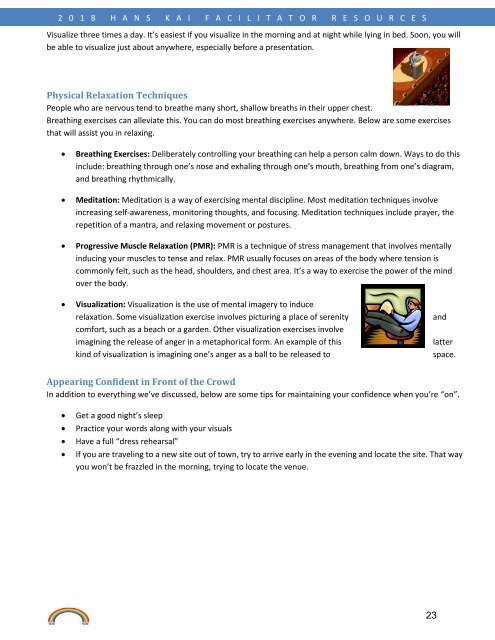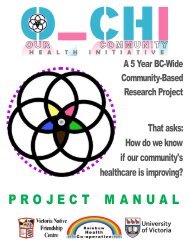2018 Hans Kai Facilitator Resources
- No tags were found...
Create successful ePaper yourself
Turn your PDF publications into a flip-book with our unique Google optimized e-Paper software.
2 0 1 8 H A N S K A I F A C I L I T A T O R R E S O U R C E S<br />
Gestures<br />
Gestures are an important tool for a presenter. The challenge is make<br />
gestures support the speaking, reinforcing ideas. Below are several basic rules<br />
for the use of gestures:<br />
• Make most gestures above the waist. (Those below the waist suggest<br />
failure, defeat, and despair.)<br />
• Hold your forearms parallel to the waist, with your elbows about 3 inches from the side.<br />
• Make your hands part of your forearm, opening them, with your fingers slightly curved. (Limp hands may<br />
indicate a lack of leadership.)<br />
• Use both hands to convey power.<br />
Gestures of direction, size, shape, description, feeling, and intensity are all effective when speaking.<br />
The Signals You Send to Others<br />
Signals are movements used to communicate needs, desires, and feelings to others. They are a form of expressive<br />
communication. More than 75% of the signals you send to others are non-verbal. People who are excellent<br />
communicators are sensitive to the power of the emotions and thoughts communicated non-verbally through<br />
signals.<br />
Types of Non-Verbal Signals: Other than gestures already discussed, signals include:<br />
• Eye contact<br />
• Posture<br />
• Body movements.<br />
They all convey important information that isn't put into words. By paying closer attention to other people's<br />
nonverbal behaviors, you will improve your own ability to communicate nonverbally. Intervals of four to five<br />
seconds of eye contact are recommended. It is also important to use a tone of voice to reinforce the words in your<br />
presentation. For example, using an animated tone of voice emphasizes your enthusiasm for a participant’s<br />
contribution in a debrief session. As a presenter, your words should match your non-verbal behaviors. If they do<br />
not, people will tend to pay less attention to what you said, and focus instead on your nonverbal signals.<br />
It’s Not What You Say, It’s How You Say It<br />
Tone of Voice: We are all born with a particular tone of voice. While most people are not gifted with a radio<br />
announcer’s voice, we can learn to improve our tone of voice. The idea is have your voice sound upbeat, warm,<br />
under control, and clear. Here are some tips to help you begin the process.<br />
• Make sure you are breathing from the diaphragm.<br />
• Stay hydrated by drinking lots of water and avoid caffeine due to its diuretic effects<br />
• Stand up tall; posture affects breathing, which affects tone.<br />
• Smile; it warms up the tone of your voice.<br />
• If your voice is particularly high or low, exercise the range of your voice by doing a sliding scale.<br />
• Record your voice and analyze the playback.<br />
• Practice speaking in a slightly lower octave. Deeper voices have more credibility than higher pitched voices.<br />
It will take getting used to pitching your voice down an octave, but it will be worth the effort.<br />
• Get feedback from a colleague or family member about the tone of your voice.<br />
21

















